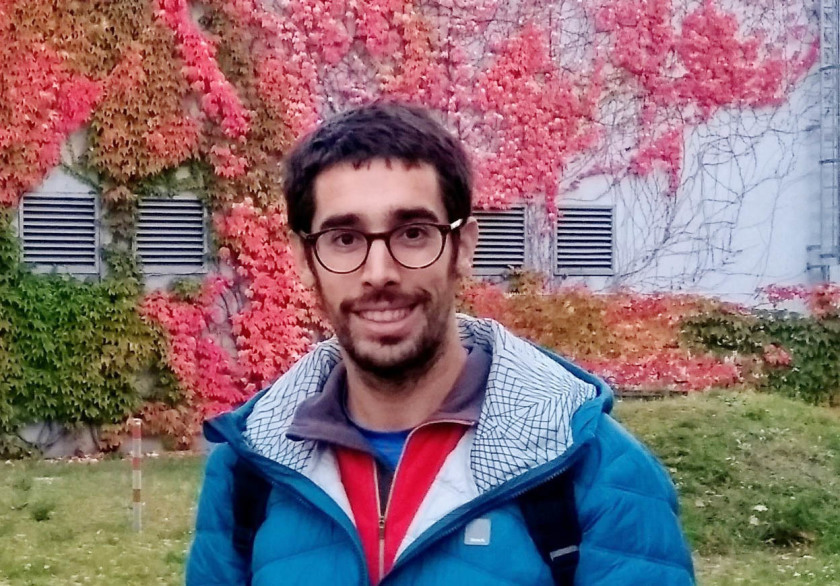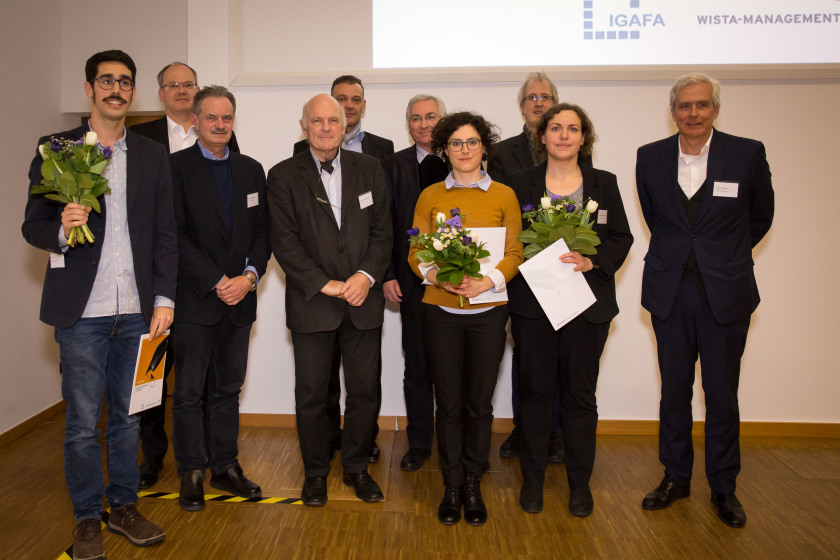Dr. Raul Garcia Diez wins the Dissertationspreis Adlershof 2017

Dr. Raul Garcia Diez was awarded for his PhD Thesis with the Dissertationspreis Adlershof 2017.

Jury with nominees and the winner, Dr. Raul Garcia Diez, (left), Photo: Matthias Brandt
With his talk on the properties of nanoparticles and how they can be measured more accurately at BESSY II, Dr. Raul Garcia Diez convinced the jury and was awarded the Dissertationspreis Adlershof 2017. Humboldt-Universität zu Berlin, IGAFA e. V. and the WISTA MANAGEMENT GmbH are the sponsors of this prize endowed with 3000 Euros. Garcia Diez completed his PhD in 2017 at PTB and TU Berlin and is now active as a post-doctoral researcher at HZB.
The use of nanoparticles in medicine is continuously growing, for example as platforms for drug-delivery or encapsulating imaging agents. In order to tailor nanoparticles for these applications, the functional properties of these particles need to be well understood.
In his thesis on "Characterization of Nanoparticles by Continuous Contrast Variation with Small-Angle X-ray Scattering" Raul Garcia Diez developed a method to study nanoparticles in a realistic environment with X-ray small-angle scattering in order to gain valuable information. The work was carried out with the HZB SAXS instrument, which is operated at the FCM beamline of the Physikalisch-Technische Bundesanstalt (PTB) in BESSY II under the cooperation between PTB and HZB.
With his work at PTB with Prof. Matthias Richter, he obtained his PhD title in May 2017 at the TU Berlin. Since then, Garcia Diez is a postdoctoral fellow with Prof. Marcus Bär at the HZB.
arö
https://www.helmholtz-berlin.de/pubbin/news_seite?nid=14787;sprache=en
- Copy link
-
Ernst Eckhard Koch Prize and Innovation Award on Synchrotron Radiation 2025
At the 27th BESSY@HZB User Meeting, the Friends of HZB honoured the dissertation of Dr Enggar Pramanto Wibowo (Friedrich-Alexander University Erlangen-Nuremberg). The Innovation Award on Synchrotron Radiation 2025 went to Prof. Tim Salditt (Georg-August-University Göttingen) and Professors Danny D. Jonigk and Maximilian Ackermann (both, University Hospital of RWTH Aachen University).
-
Synchrotron radiation sources: toolboxes for quantum technologies
Synchrotron radiation sources generate highly brilliant light pulses, ranging from infrared to hard X-rays, which can be used to gain deep insights into complex materials. An international team has now published an overview on synchrotron methods for the further development of quantum materials and technologies in the journal Advanced Functional Materials: Using concrete examples, they show how these unique tools can help to unlock the potential of quantum technologies such as quantum computing, overcome production barriers and pave the way for future breakthroughs.
-
Peat as a sustainable precursor for fuel cell catalyst materials
Iron-nitrogen-carbon catalysts have the potential to replace the more expensive platinum catalysts currently used in fuel cells. This is shown by a study conducted by researchers from the Helmholtz-Zentrum Berlin (HZB), Physikalisch-Technische Bundesanstalt (PTB) and universities in Tartu and Tallinn, Estonia. At BESSY II, the team observed the formation of complex microstructures within various samples. They then analysed which structural parameters were particularly important for fostering the preferred electrochemical reactions. The raw material for such catalysts is well decomposed peat.
